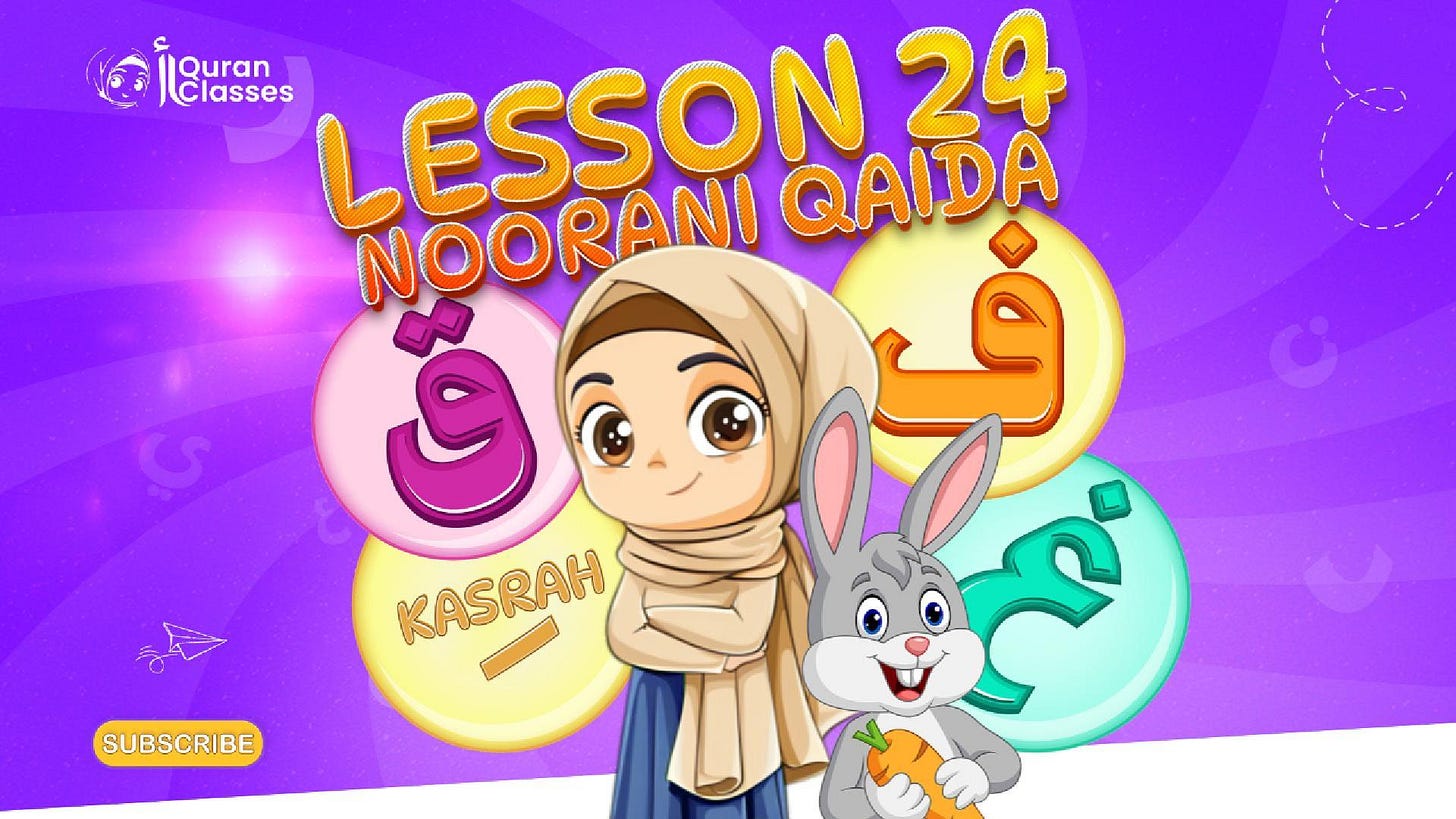Bayt Al-Quran: Noorani Qaida-Lesson#24| Friday
Learning the Arabic Letters: فِ, قِ, and غِ with Kasrah Vowel
Dear Parents and Little Learners,
Welcome to Lesson #24 — and what a special one it is! Today, we meet three fascinating letters that each have their own unique twist: فِ, قِ, and غِ.
It all begins in the Land of Sounds, where the gentle فِ (Faa) floats like a feather — soft, light, and easy to say. Then comes the deep, strong قِ (Qaaf), echoing from the back of the throat like a distant drum. And finally, we meet the mysterious غِ (Ghain), a letter that sounds like a bubbling stream deep in a hidden cave — a little tricky, but fun once you get the hang of it!
In this lesson, your child will explore how these letters look, how their Kasrah ( ـِ ) changes their sound to a short “i”, and how to confidently pronounce and recognize them in words. From tracing to sound matching, it’s going to be a thrilling stop on their Noorani Qaida journey!
Let’s Start!
Key Learning Objectives
Recognize the Arabic letters ف, ق, and غ in their isolated forms.
Pronounce the short vowel Kasrah ( ـِ ) correctly with each letter, producing فِ, قِ, and غِ.
Differentiate between the soft sound of فِ, the deep sound of قِ, and the unique throaty sound of غِ.
Practice tracing and writing the letters with the Kasrah to build letter-shape memory.
Build early reading fluency by identifying these letters with Kasrah in simple combinations or words.
Strengthen auditory discrimination by distinguishing فِ, قِ, and غِ from other similar sounds.
🎥 Watch Today’s Lesson Video:
Let’s Practice with Play — Your Faa, Qaaf & Ghain Activity Sheet!
Ready to bring today’s letters to life? We’ve created a colorful and engaging Activity Sheet to help your child explore فِ, قِ, and غِ through play-based learning!
This printable sheet is filled with fun challenges like:
Tracing the shapes of ف, ق, and غ with Kasrah
Matching each letter to its correct sound
Identifying the letters in mini-words or patterns
Coloring and circling games to boost recognition and fine motor skills
Perfect for after-class review, quiet-time practice, or a joyful weekend activity, this sheet makes learning feel like an adventure. So grab some crayons, print your copy, and enjoy watching your little learner shine with every Kasrah sound they master!
Fun & Play-Based Practice Ideas
Sound Toss Game
Write فِ, قِ, and غِ on separate index cards. Place them in a circle on the floor. Call out a sound (e.g., "قِ!") and have your child toss a soft ball or beanbag onto the correct card. It’s a great way to mix movement with memory!Mystery Sound Box
Fill a small box or bag with items that start with similar sounds or Arabic letters. Let your child pull out one at a time and guess which sound it matches. For example, a picture of a "قلب" (heart) goes with قِ, or a "غيمة" (cloud) goes with غِ. Bonus points for trying to say the word!Kasrah Detective
Hide flashcards of فِ, قِ, and غِ around the room. Hand your child a magnifying glass and turn them into a Kasrah Detective! Every time they find a card, they must say the sound out loud — maybe even act out the letter with a fun gesture!
We’d Love to Hear About Your Little Learner’s Progress!
How did your child enjoy discovering فِ, قِ, and غِ in today’s Kasrah adventure? Whether it was a giggle during the Sound Toss, a proud tracing moment, or a fun round of Kasrah Detective — we’d be thrilled to hear about it!
Feel free to share a quick comment, a snapshot of their worksheet, or even a short video. Teacher Noura would absolutely love to see how your child is progressing and send them a cheerful message of encouragement, inshaAllah.
Each sound your child masters brings them closer to confidently reading Arabic and connecting with the Quran. And your support makes all the difference — one Kasrah, one smile, and one letter at a time. 🌟
Keep going — you’re doing an amazing job!



